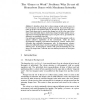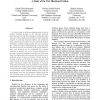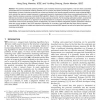145 search results - page 4 / 29 » The Maximum Distinguishing Number of a Group |
CEEMAS
2005
Springer
14 years 29 days ago
2005
Springer
A honeybee colony has to choose among several nectar sources in the environment, each fluctuating in quality over time. Successful forager bees return to the hive and perform dance...
QSIC
2005
IEEE
14 years 1 months ago
2005
IEEE
This paper proposes a stochastic voting for testing a large number of Web Services (WS) under group testing. In the future, a large number of WS will be available and they need to...
AICCSA
2005
IEEE
14 years 1 months ago
2005
IEEE
A critical issue in multicast communication is how to identify multicast groups. In the Internet, multicast addresses and port numbers distinguish multicast groups from each other...
TKDE
2012
11 years 9 months ago
2012
—The pairwise constraints specifying whether a pair of samples should be grouped together or not have been successfully incorporated into the conventional clustering methods such...
TSP
2008
13 years 7 months ago
2008
For orthogonal space-time block coded orthogonal frequency division multiplexing (OSTBC-OFDM) systems, many of the existing blind detection and channel estimation methods rely on t...



